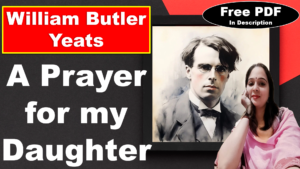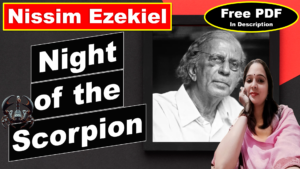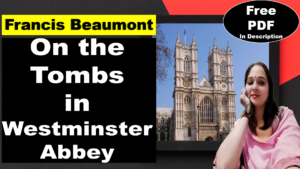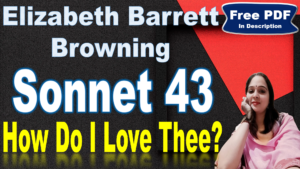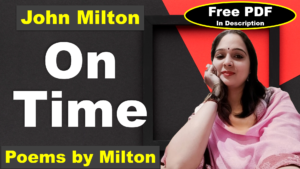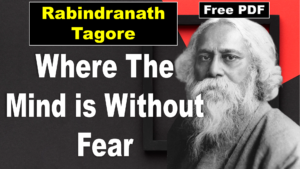Since there’s no help by Michael Drayton | Since there’s no help | Michael Drayton | Explanation | Summary | Key Points | Word Meaning | Questions Answers | Free PDF Download – Easy Literary Lessons
Since there’s no help
Since there’s no help, come let us kiss and part.
Nay, I have done, you get no more of me;
And I am glad, yea glad with all my heart,
That thus so cleanly I myself can free.
Shake hands for ever, cancel all our vows,
And when we meet at any time again,
Be it not seen in either of our brows
That we one jot of former love retain.
Now at the last gasp of Love’s latest breath,
When, his pulse failing, Passion speechless lies;
When Faith is kneeling by his bed of death,
And Innocence is closing up his eyes—
Now, if thou wouldst, when all have given him over,
From death to life thou might’st him yet recover!
line-by-line explanation of the poem
Since there’s no help, come let us kiss and part.
Explanation
The poem opens with a declaration of acceptance and finality. “No help” suggests their situation is beyond repair. The immediate suggestion of a kiss suggests a lingering affection despite the decision to part.
Nay, I have done, you get no more of me;
Explanation
The speaker emphasizes his resolve to end the relationship. “Nay” strengthens the rejection, and “you get no more of me” makes it definitive.
Poetic Device
Repetition: “Nay” reinforces decisiveness
Alliteration: more, me
And I am glad, yea glad with all my heart,
That thus so cleanly I myself can free.
Explanation
Despite the pain, the speaker claims to be “glad” about the separation. The repetition underlines the attempt to convince himself, suggesting possible inner conflict.
The speaker finds satisfaction in the clean break, emphasizing personal liberation. “Cleanly” reinforces the desire for a clear and uncomplicated separation.
Poetic Device
Repetition: “glad” highlights possible insincerity
Alliteration: “c” sound emphasizes “cleanly” and “can”, and “t” sound emphasizes “that” and “thus”
Shake hands for ever, cancel all our vows,
Explanation
The speaker suggests a symbolic gesture of finality, severing all ties and promises. “Shake hands forever” suggests a formal and permanent goodbye.
Poetic Device
Metaphor: “shake hands forever” represents ending the relationship.
And when we meet at any time again,
Explanation
The speaker anticipates future encounters, emphasizing the need for complete detachment. “Any time again” suggests the possibility of future meetings.
Poetic devices
Foreshadowing: hints at future encounters.
Alliteration: When, we
Be it not seen in either of our brows
That we one jot of former love retain.
Explanation
The speaker urges that, upon meeting again, there should be no indication on either person’s face that they still harbour any remnants of past love. The speaker emphasizes the desire for a complete break, with no trace of the love that existed before.
Poetic devices
Synecdoche: “brows” represent overall expression.
Hyperbole: “one jot” exaggerates the extent of desire to eradicate love.
Enjambment: When a line runs on into the next without punctuation, bringing momentum and maintaining sense
Now at the last gasp of Love’s latest breath,
When, his pulse failing, Passion speechless lies;
Explanation
The speaker utilizes a powerful metaphor, comparing their love to a dying person. “Last gasp” highlights the critical state of their relationship. The personification of “Passion” and its “speechless” state further emphasize the deathlike situation of their love. “Pulse failing” signifies the fading life force of their affection.
Poetic devices
Metaphor: The metaphor of love’s “last gasp” creates a vivid image of love on the verge of expiration.
Personification: The personification of Passion as lying speechless adds emotional depth.
Caesura: When a pause occurs midway through a line, through the use of punctuation
Alliteration: “last, love, latest” and “pulse, passion”
When Faith is kneeling by his bed of death,
And Innocence is closing up his eyes—
Explanation
“Faith” represents hope and belief in their relationship. Its kneeling position suggests desperation and acceptance of the imminent end. “Innocence” symbolizes the purity and naivete of their love. Its action of closing the eyes suggesting the end of purity and naivety in the relationship.
Poetic devices
Personification: “Faith” as a kneeling figure and “Innocence” as an acting entity.
Now, if thou wouldst, when all have given him over,
From death to life thou might’st him yet recover!
Explanation
The speaker introduces a twist, suggesting that if the other person desires, there might be a chance to revive love even when everyone else has given up. The speaker then concludes with a hopeful note, suggesting that the other person could still bring love back to life, moving it from a state of death to revival.
Poetic devices
Metaphor: love compared to a dying person
Summary
Michael Drayton’s sonnet “Since there’s no help” is a powerful exploration of heartbreak and the lingering embers of hope amidst a fading love. Here’s a summary with key insights:
Initial Resignation and Acceptance:
The poem opens with a melancholic tone, accepting the demise of the relationship (“no help”).
The speaker suggests a swift, clean break (“come let us kiss and part”).
He claims to be “glad” about the separation, but the repetition and emphasis hint at deeper turmoil and conflicting emotions.
He desires a complete erasure of their past connection, advocating for shaking hands, cancelling vows, and maintaining an emotionless facade in future encounters.
Vivid Metaphor of Love’s Death:
The poem shifts to a powerful metaphor, depicting their love as a dying patient on its last breath.
Love is personified as gasping for air, with Passion speechless and Faith kneeling by its deathbed. Innocence, symbolizing the purity of their bond, closes its eyes, signifying the finality of their demise.
This imagery vividly emphasizes the intensity of their emotional pain and the perceived inevitability of their separation.
Unexpected Glimpse of Hope:
In the final couplet, the poem takes a surprising turn. Despite earlier pronouncements, the speaker acknowledges that if his beloved were to reach out (“if thou wouldst”), there might still be a chance to revive their dying love (“recover”).
This sudden flicker of hope adds ambiguity and complexity to the speaker’s emotions. It suggests that his acceptance might not be as complete as he initially declared, possibly harboring hidden longing for reconciliation.
Overall Themes:
The poem explores themes of love and loss, the struggle between acceptance and longing, and the complexities of human emotions.
The use of metaphor and personification adds depth and emotional resonance to the speaker’s internal conflict.
The poem’s ending leaves the reader pondering the ultimate fate of their love, prompting reflection on the challenges and possibilities of overcoming heartbreak.
Structure and Form:
The poem follows the structure of a english sonnet with 14 lines, adding formal closure and reinforcing focus.
The volta (turn) between lines 12 and 13 marks a crucial shift in emotions, keeping the reader engaged.
Iambic pentameter rhythm and regular rhyme scheme create a musicality that complements the poem’s emotional intensity.
“Idea 61” is a potent blend of form, imagery, and emotion, making it a timeless exploration of love’s bittersweet complexities. The poem’s lingering hope invites readers to empathize with the speaker’s journey and contemplate the enduring power of love, even in the face of loss.
Key Points
Author Michael Drayton was an English poet born in 1563.
Form This poem is the 61st sonnet in a sequence called Idea’s Mirror, published around 1594. 14 lines divided into 3 quatrains and a final couplet, with ABAB CDCD EFEF GG rhyme scheme and iambic pentameter rhythm (unstressed-stressed syllable pattern
Speaker The speaker in the poem is a man who has been trying to woo a woman, but has now lost hope.
Setting The setting is not explicitly stated, but it’s a personal conversation between the speaker and the woman he loves.
Theme The theme revolves around unrequited love and the complex emotions that come with it.
Plot The speaker declares that he and the woman he loves will become mere acquaintances in the future1. He initially asserts that their love is over, but by the end of the poem, he reveals that he still harbors feelings for her.
Tone The tone is one of resignation and sadness, but also contains a glimmer of hope.
Style Vivid imagery, strong metaphors, formal structure, musicality through rhythm and rhyme.
Message The message of the poem is that love can be complex and challenging. Even when we try to move on, our feelings can still linger. The speaker suggests that if the woman wishes, he could rekindle his supposedly dead love.
“Since there’s no help, come let us kiss and part” by Michael Drayton is an English sonnet. Here are the key features of its structure and form:
Length and Rhyme Scheme
The poem consists of 14 lines.
It follows a rhyme scheme of ABABCDCDEFEFGG.
Meter
The poem is written in iambic pentameter. This means each line consists of five pairs of unstressed and stressed syllables.
Turn or Volta
The “turn” or “volta” is a point in a sonnet where the theme or tone changes. In Shakespearean sonnets, this usually occurs at the ninth line or the start of the third quatrain. However, in this poem, the turn is more subtle and occurs towards the end, where the speaker reveals that he still harbours feelings for the woman.
Michael Drayton
Birth and Early Life: Michael Drayton was born in 1563 in Hartshill, Warwickshire, England. He spent his early years in the service of Sir Henry Goodere, who provided for his educatio.
Education: There are speculations that Drayton might have studied at the University of Oxford, but recent work suggests that his social status was likely lower than that of his contemporaries who obtained university degrees.
Career: Drayton came to prominence as a poet in the Elizabethan era and continued to write through the reigns of James I and Charles I. His works mainly consisted of historical poetry.
First English Odes: He was the first English-language author to write odes in the style of Horace.
Works: His first book, “The Harmony of the Church”, was published in 1590. Other notable works include “Idea: The Shepherd’s Garland” (1593), “Ideas Mirrour” (1594), “Endimion and Phoebe: Ideas Latmus” (1595), and “The Legend of Piers Gaveston” (1593).
Poly-Olbion: His most ambitious work is “Poly-Olbion”, a comprehensive record of the Elizabethan discovery of England.
Death: Drayton passed away in London on December 23, 1631.
Word Meaning
| Line | Tough Word | Meaning in English | Meaning in Hindi |
| 1 | Part | Apart | अलग |
| 2 | Nay | An emphatic way of saying “no” | नहीं |
| 3 | Glad | Feeling happy or pleased | खुश |
| 4 | Cleanly | In a complete and thorough way | पूरी तरह से |
| 5 | Vows | Solemn promises | प्रतिज्ञा |
| 7 | Brows | The hair above the eyes | भौंहें |
| 8 | Jot | A very small amount or quantity | रंच |
| 8 | Retain | To keep or hold something | बनाए रखना |
| 9 | Gasp | A short, difficult breath | हांफना |
| 9 | Latest | Last | अंतिम |
| 10 | Passion | Intense emotion or enthusiasm | जुनून |
| 11 | Faith | Belief or trust | विश्वास |
| 11 | Kneeling | to rest on one or both knees | घुटना टेककर |
| 12 | Innocence | The state of being pure and naive | मासूमियत |
| 13 | Thou | Archaic word, which means “You” | तुम |
| 13 | Wouldst | Archaic form of “would” | चाहोगे |
| 14 | Recover | To return to health or a previous state | ठीक होना |
Very Short Answer Questions
Who is the author of the poem “Since there’s no help”?
The author of the poem is Michael Drayton.
Who is the speaker in the poem?
The speaker is a man who has been trying to woo a woman, but has now lost hope.
What is the setting of the poem?
The setting is not explicitly stated, but it’s a personal conversation between the speaker and the woman he loves.
What is the theme of the poem?
The theme revolves around unrequited love and the complex emotions that come with it.
What is the plot of the poem?
The speaker declares that he and the woman he loves will become mere acquaintances in the future.
What is the length of the poem?
The poem consists of 14 lines.
What is the rhyme scheme of the poem?
The poem follows a rhyme scheme of ABABCDCDEFEFGG.
What is the meter of the poem?
The poem is written in iambic pentameter.
Where does the turn or volta occur in the poem?
The turn or volta occurs towards the end, where the speaker reveals that he still harbours feelings for the woman.
What is the speaker’s initial assertion in the poem?
The speaker initially asserts that their love is over.
What does the speaker reveal at the end of the poem?
At the end of the poem, the speaker reveals that he still harbours feelings for the woman.
What does the speaker suggest about his love for the woman?
The speaker suggests that if the woman wishes, he could rekindle his supposedly dead love.
What is the speaker’s attitude towards the woman at the beginning of the poem?
At the beginning of the poem, the speaker is resigned and ready to give up on the relationship.
What is the speaker’s attitude towards the woman at the end of the poem?
At the end of the poem, the speaker still harbours feelings for the woman.
What is the speaker’s state of mind throughout the poem?
The speaker’s state of mind is complex and filled with conflicting emotions.
What does the speaker hope for at the end of the poem?
The speaker hopes that he could rekindle his supposedly dead love if the woman wishes.
Short Answer Questions
What is the context in which the poem “Since there’s no help” was written?
The poem is the 61st sonnet in a sequence called Idea’s Mirror, published around 1594. The sonnets are addressed to a woman the poet was attempting to woo.
What is the main theme of the poem?
The main theme of the poem is unrequited love and the complex emotions that come with it.
How does the speaker express his feelings towards the woman he loves in the poem?
The speaker begins by asserting that he’s done trying to love someone. He states that there’s no way their love is going to work, so they should “kiss and part.” However, by the end of the poem, it’s revealed that the speaker is still harbouring emotions for her.
What is the structure and form of the poem?
The poem is an English or Shakespearean sonnet, consisting of 14 lines and following a rhyme scheme of ABABCDCDEFEFGG. It is written in iambic pentameter.
What is the tone of the poem?
The tone is one of resignation and sadness, but also contains a glimmer of hope.
What is the message conveyed by the speaker in the poem?
The message of the poem is that love can be complex and challenging. Even when we try to move on, our feelings can still linger.
How does the speaker’s attitude change throughout the poem?
The speaker’s attitude changes from one of resignation and readiness to give up on the relationship, to revealing that he still harbours feelings for the woman.
What is the significance of the turn or volta in the poem?
The turn or volta occurs towards the end, where the speaker reveals that he still harbours feelings for the woman. This is significant as it reveals the complexity of the speaker’s emotions and the lingering nature of his love.
What is the speaker’s state of mind throughout the poem?
The speaker’s state of mind is complex and filled with conflicting emotions. He tries to convince himself that he’s ready to give up on the relationship, but he’s really not.
What does the speaker hope for at the end of the poem?
At the end of the poem, the speaker hopes that he could rekindle his supposedly dead love if the woman wishes.
Essay Type Questions
1. Write the critical appreciation of the poem.
Michael Drayton’s sonnet, “Since there’s no help” is a beautiful expression of mixed feelings during a breakup. The poem uses vivid language and a clever change in tone to navigate the difficult emotions of heartbreak. Its well-crafted structure, emotional words, and exploration of conflicting feelings make it more than just a personal story. It becomes a timeless reflection on the strength of love and the sad but beautiful experience of moving on.
Structure and Form:
The sonnet adheres to the rigid form of a Shakespearean sonnet, with its fourteen lines divided into three quatrains and a final couplet. This structure provides a sense of order and containment, mirroring the speaker’s attempt to control his emotions and compartmentalize the pain of loss. The ABAB CDCD EFEF GG rhyme scheme adds a layer of musicality, while the iambic pentameter rhythm mimics the rhythm of a beating heart, underscoring the raw emotion at the poem’s core.
Theme:
The poem explores the complex theme of heartbreak, delving into the struggle between acceptance and lingering hope. The speaker grapples with the realization that their love is beyond repair (“Since there’s no help”), yet his pronouncements of gladness (“And I am glad, yea glad with all my heart”) ring hollow, hinting at a deeper turmoil. This tension between acceptance and longing forms the poem’s central emotional arc, culminating in the final couplet’s unexpected glimmer of hope (“Now, if thou wouldst, when all have given him over,/From death to life thou might’st him yet recover!”).
Imagery:
Drayton masterfully employs imagery to paint a vivid picture of love’s demise. The poem opens with the symbolic act of a kiss, a final gesture of affection before parting. The metaphor of love as a dying patient (“Now at the last gasp of Love’s latest breath”) is particularly powerful, personifying the relationship and amplifying the speaker’s grief. The imagery of closing eyes (“Innocence is closing up his eyes”) suggests a finality and acceptance of death, further emphasizing the sense of loss.
Poetic Devices:
The poem’s effectiveness lies not only in its thematic depth but also in its masterful use of poetic devices.
1. Metaphor: Love’s demise is not merely stated, it’s experienced through the powerful metaphor of a dying patient. Phrases like “Love’s latest breath” and “Passion speechless” personify the relationship, making its demise feel visceral and agonizing. This metaphor amplifies the speaker’s grief and emphasizes the finality he perceives.
2. Personification: Extending the metaphor, elements like “Faith” and “Innocence” are personified, kneeling at the “deathbed” of love. This imbues the abstract concepts with human emotions, drawing the reader deeper into the emotional landscape of the poem. The closing of “Innocence’s eyes” suggests a finality and acceptance of death, further deepening the sense of loss.
3. Synecdoche: “Brows” become a symbol for the entire face, representing outward expressions of emotion. By focusing on this specific part, the speaker emphasizes his desire to mask any lingering feelings, creating a sense of stoicism and control.
4. Hyperbole: The speaker’s claim to be “glad” about the separation is amplified by the hyperbole of “glad with all my heart.” This exaggeration hints at the underlying turmoil and the speaker’s struggle to reconcile his pronouncements with his true emotions. Similarly, “one jot of former love” signifies even the smallest trace, highlighting the intensity of his desire to eradicate any remnants of the past.
5. Repetition: Words like “glad” and “brows” are repeated, not for redundancy, but to emphasize the speaker’s determination to convince himself of his detachment. This repetition becomes a mantra, revealing the effort involved in maintaining the facade of acceptance.
6. Enjambment: Lines often run into the next, creating a sense of urgency and emotional overflow. This stylistic choice mirrors the speaker’s inability to contain his conflicting emotions, blurring the boundaries between acceptance and longing.
7. Caesura: The pause within the line after “brows” in the final couplet creates a dramatic tension. It emphasizes the separation between their past and present, adding weight to the speaker’s conditional hope for reconciliation.
8. Alliteration: The harsh “b” and “t” sounds in “Be it not seen in either of our brows” create a hissing effect, mirroring the speaker’s determination to erase any trace of their past love. This alliteration adds a layer of bitterness and finality to the statement.
Conclusion:
“Since there’s no help, come let us kiss and part” is more than just a poem about heartbreak. It is a microcosm of the human experience, capturing the push and pull of emotions, the struggle between acceptance and longing, and the enduring power of love even in the face of loss. Through its masterful use of form, imagery, and poetic devices, Drayton paints a poignant and relatable portrait of heartache, reminding us that even in the darkest moments, a flicker of hope can remain. The poem’s lasting impact lies in its ability to resonate with anyone who has ever loved and lost, offering a shared experience of grief and a gentle reminder that even in the ashes of love, the embers of possibility can still glow.


